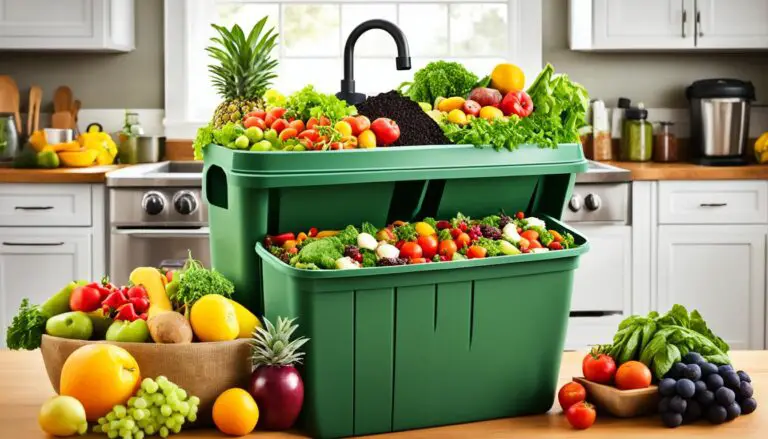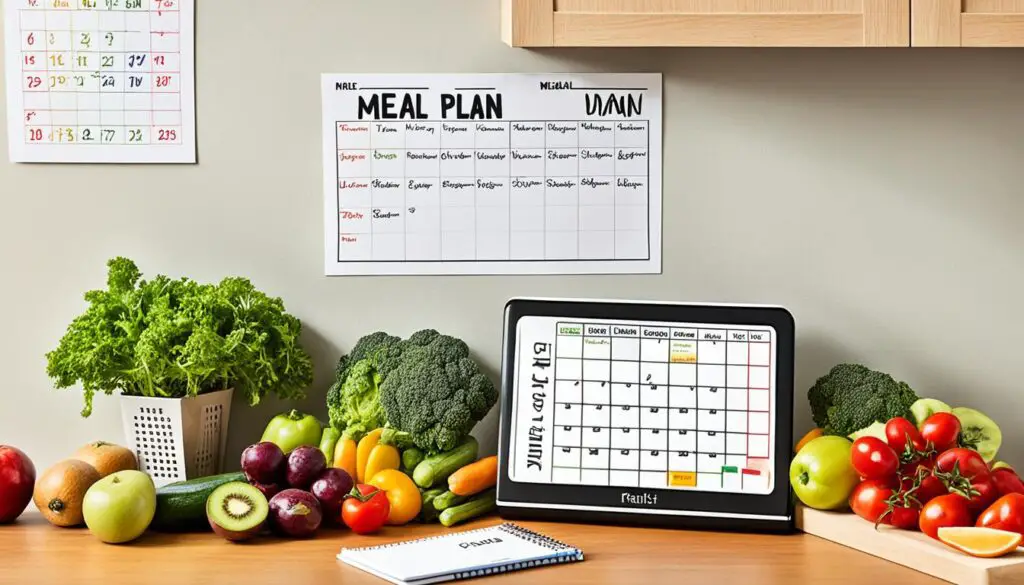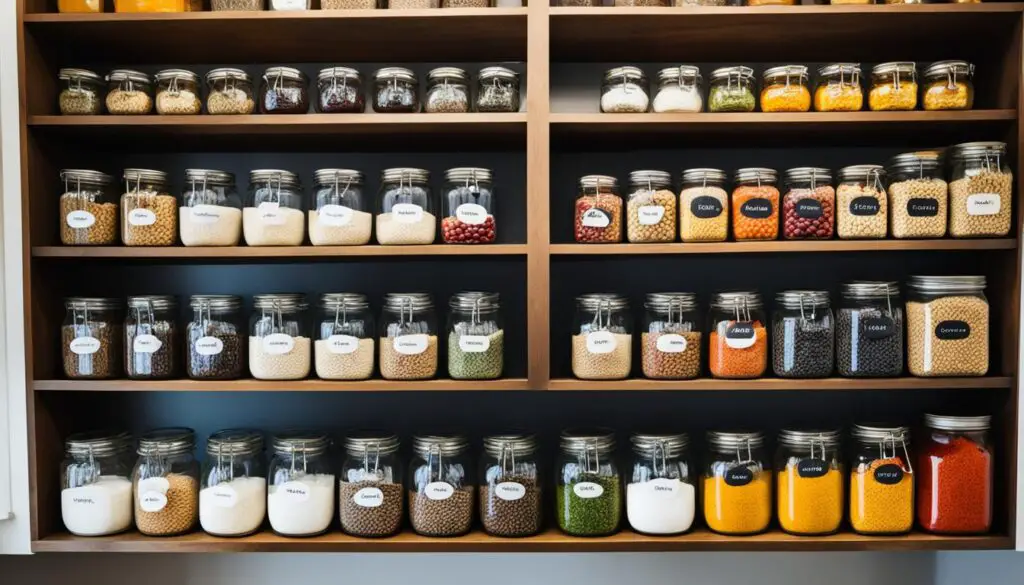Hey there! I’m excited to share some valuable insights on reducing food waste in your household and embracing a more sustainable lifestyle.
Americans waste about 30-40% of their food supply, equating to over 133 billion pounds of food wasted each year. This alarming statistic not only impacts our wallets but also contributes to hunger and has a significant environmental footprint.
By implementing a few simple strategies, we can make a positive change and create a greener kitchen. Together, let’s take a closer look at the impact of food waste and explore practical tips for minimizing it in our everyday lives.
Key Takeaways:
- Reducing food waste helps combat hunger and reduces our environmental impact.
- Understanding the environmental consequences of food waste is essential for motivating change.
- Proper meal planning and smart grocery shopping are key in reducing food waste.
- Learn how to store different types of food properly to extend their shelf life.
- Get creative with cooking and repurposing leftovers to avoid waste.
Understanding the Impact of Food Waste
When it comes to food waste, the consequences extend beyond just discarded leftovers. The environmental impact of food waste is significant, with far-reaching implications for our planet. By understanding the consequences and taking action, we can make a positive change to reduce our food waste impact and minimize our environmental footprint.
One of the key environmental concerns associated with food waste is its contribution to greenhouse gas emissions. When food waste ends up in landfills, it decomposes and releases methane, a potent greenhouse gas that is significantly more impactful than carbon dioxide in terms of its warming potential. Methane emissions from food waste further contribute to climate change and exacerbate global warming. It’s estimated that food waste is responsible for 8% of greenhouse gas emissions worldwide.
Additionally, the production, transportation, and storage of food require valuable resources such as water, land, and energy. When food is wasted, these resources go to waste as well. For example, growing crops requires vast amounts of water, and when food is not consumed and thrown away, all the water used during cultivation is also wasted. The same goes for land resources that could have been used for other purposes and the energy expended throughout the food supply chain, from farming to distribution.
It’s crucial to grasp the environmental footprint of food waste to appreciate the urgency of taking action. By reducing our own food waste and advocating for systemic changes, we can collectively minimize the negative impact and work towards a more sustainable future.
Planning and Shopping Wisely
Proper meal planning and smart grocery shopping are crucial steps in reducing food waste and creating a more sustainable kitchen. By being mindful of what you purchase and how you plan your meals, you can minimize waste and ensure that food is consumed before it spoils.
When it comes to meal planning, taking inventory of what you already have in your pantry and refrigerator is essential. This step helps you identify ingredients that need to be used soon, preventing them from being forgotten or discarded. By incorporating these items into your meal plan, you can reduce waste and save money.
Creating a detailed grocery list is another key strategy in shopping wisely. By making a list before heading to the store, you can avoid impulse buys and unnecessary purchases. Stick to your list and resist the temptation to buy items that are not essential for your planned meals. This practice not only reduces waste but also helps you stay within your budget.
If possible, opt for smaller quantities when buying perishable items. This approach ensures that you consume them before they spoil. Buying in bulk might seem cost-effective, but it can lead to food waste if you are unable to use or store the items properly.
Benefits of Meal Planning and Smart Grocery Shopping:
- Reduced food waste
- Savings on grocery expenses
- Efficient use of ingredients
- Minimized reliance on convenience foods
By incorporating these practices into your routine, you contribute to a more sustainable lifestyle and make a positive impact on the environment. With proper meal planning and smart grocery shopping, you can enjoy delicious meals while reducing waste and saving money.
Comparing the Impact of Meal Planning and Impulse Shopping
| Factors | Meal Planning | Impulse Shopping |
|---|---|---|
| Food Waste | Minimized through planned consumption | Higher chances of unused and spoiled food |
| Financial Impact | Cost-effective, as only necessary items are purchased | Potential overspending on unnecessary items |
| Meal Variety | Allows for more diverse and planned meals | Tendency to rely on repetitive or convenience meals |
| Environmental Impact | Reduces overall food waste and its ecological consequences | Contributes to increased greenhouse gas emissions |
To further enhance your meal planning and grocery shopping experience, consider using helpful apps and resources available. These tools can assist in creating meal plans, generating grocery lists, and providing recipe ideas based on the ingredients you have on hand.
By implementing these strategies, you not only reduce food waste but also streamline your cooking process and make informed choices while grocery shopping.
Proper Storage and Organization
I want to emphasize the importance of proper food storage and organization in minimizing spoilage and extending the shelf life of your groceries. By implementing effective storage techniques, you can significantly reduce food waste and keep your food fresh for longer.
Here are some key tips to help you maximize the shelf life of your groceries:
Separate Fruits and Vegetables
Store fruits and vegetables separately to prevent them from speeding up the spoilage process. Some fruits release ethylene gas, which can cause vegetables to spoil faster. Keep them in different compartments or containers to extend their freshness.
Utilize Airtight Containers
Invest in airtight containers to store perishable items, such as leftovers or cut fruits and vegetables. These containers help maintain optimal humidity levels and keep your food fresh for longer periods. Label containers with the date to keep track of freshness.
Make the Most of Your Freezer
The freezer can be a powerful tool in extending the shelf life of various foods. Freeze items like bread, meats, and fruits before they reach their expiration dates. Properly wrap and label items to avoid freezer burn and ensure you use them within a reasonable timeframe.
Proper storage techniques can significantly minimize spoilage and keep your food fresh for longer.
Types of Food and Their Recommended Storage Methods
| Food Type | Recommended Storage Method |
|---|---|
| Fruits | Refrigerate in airtight containers or bags |
| Vegetables | Store in the crisper drawer or wrap in damp towels |
| Dairy Products | Keep in the coldest part of the refrigerator |
| Meats and Poultry | Refrigerate or freeze in airtight containers or freezer bags |
| Bread and Bakery Items | Store in a cool, dry place or freeze in freezer bags |
By following these practical methods and storing different types of food appropriately, you can minimize spoilage, reduce food waste, and make the most of your groceries.
Remember, proper storage and organization go hand in hand with reducing food waste and creating a more sustainable kitchen.
Creative Cooking and Leftover Management
When it comes to reducing food waste, getting creative in the kitchen and effectively managing leftovers are key strategies. By utilizing recipes that make use of ingredients you already have and repurposing leftover food, you can minimize waste and create delicious meals. Embracing these practices ensures that no food goes to waste while adding variety to your menu.
“Waste not, want not.”
Repurposing leftovers:
- Stale bread can be transformed into flavorful croutons or ground into breadcrumbs for use in meatballs or coatings. It’s a great way to breathe new life into bread that might otherwise go to waste.
- Excess cooked vegetables can be combined to make a flavorful frittata. Simply sauté them in a pan, add beaten eggs, and bake until set. It’s a versatile and satisfying dish that can be customized to suit your taste.
- Mashed potatoes can be formed into patties and fried to create crispy potato pancakes. They make a delicious side dish or even a light main course.
Creating a Repurposed Leftovers Meal Plan
A great way to make the most of your leftovers is to create a repurposed leftovers meal plan. This involves planning meals around the ingredients you already have on hand and incorporating leftovers from previous meals. Not only does this minimize waste, but it also saves time and money.
Example of a Repurposed Leftovers Meal Plan:
| Day | Breakfast | Lunch | Dinner |
|---|---|---|---|
| Monday | Vegetable Frittata | Tuna Salad Wrap | Chicken Stir-Fry (using leftover chicken) |
| Tuesday | Crispy Potato Pancakes | Leftover Chicken Stir-Fry | Spaghetti Bolognese (using leftover spaghetti sauce) |
| Wednesday | French Toast (using stale bread) | Leftover Spaghetti Bolognese | Vegetable Curry (using leftover vegetables) |
| Thursday | Smoothie Bowl | Vegetable Curry | Leftover Vegetable Frittata |
| Friday | Egg and Vegetable Muffins | Leftover Vegetable Curry | Homemade Pizza (using leftover vegetables as toppings) |
By repurposing leftovers and incorporating them into your meal plan, you not only reduce waste but also enjoy a diverse range of dishes throughout the week. This approach allows you to fully utilize the ingredients you have on hand, resulting in fewer trips to the grocery store and a more sustainable kitchen.
Next, we’ll explore another important aspect of reducing food waste: practicing portion control and mindful eating.
Portion Control and Mindful Eating
Practicing portion control and mindful eating is crucial for reducing plate waste. By serving appropriate portion sizes and paying attention to hunger cues, you can avoid excess food being thrown away and promote mindful consumption. Let’s explore some helpful strategies for practicing portion control and mindful eating:
- Assess your portion sizes: Take a moment to evaluate the portion sizes you typically serve yourself and your family. Consider using smaller plates and bowls to encourage smaller portions and prevent overeating.
- Listen to your body: Pay attention to your hunger and fullness cues. Eat slowly and savor each bite, allowing your body to recognize when it’s satisfied. Avoid the temptation to overfill your plate, and stop eating when you feel comfortably full.
- Practice mindful cooking: When preparing meals, consider the portion sizes that best align with your dietary needs. Be mindful of recipes that may yield large quantities and adjust them accordingly to prevent unnecessary leftovers.
- Share meals: If dining with others, encourage everyone at the table to finish their food before taking more. This practice not only reduces plate waste but also fosters mindful consumption and provides an opportunity for shared experiences.
“By serving appropriate portion sizes and paying attention to hunger cues, you can avoid excess food being thrown away and promote mindful consumption.”
With these strategies in mind, you can make a positive impact on reducing plate waste and adopting a more sustainable approach to eating.
Composting and Donating
When it comes to reducing food waste, composting and donating are two valuable practices that can make a significant difference.
Composting is a sustainable solution that transforms food scraps into nutrient-rich soil, which can then be used for gardening. By diverting food waste from landfill, composting helps minimize the environmental impact and contributes to a more sustainable ecosystem. Instead of throwing food scraps in the trash, consider starting a composting system in your backyard or explore community composting programs in your area. Composting not only reduces waste but also provides a valuable resource for growing healthy plants and gardens.
On the other hand, food donation is an effective way to give back to the community while diverting edible food from ending up in the trash. If you have excess food that is still edible but won’t be used, consider donating it to local food banks or shelters where it can benefit individuals and families in need. Food donation helps address hunger while reducing food waste, making a positive impact on both social and environmental fronts.
By composting and donating, we can actively contribute to waste diversion efforts and create a more sustainable and compassionate society.
Conclusion
Reducing food waste in your household is a simple yet powerful step towards a more sustainable lifestyle. By implementing meal planning, proper storage techniques, creative cooking, portion control, and mindful eating, you can significantly minimize food waste and make your kitchen greener.
Meal planning and smart grocery shopping are essential for reducing waste. Taking inventory of what you already have and making a detailed grocery list can help avoid impulse buys and ensure that perishable items are consumed before they spoil.
Proper storage and organization techniques, such as using airtight containers and utilizing the freezer effectively, can help extend the shelf life of your groceries and prevent them from going to waste. Additionally, getting creative with your cooking and repurposing leftovers can transform excess food into delicious meals.
Practicing portion control and mindful eating is crucial for reducing plate waste. Serving appropriate portion sizes and paying attention to hunger cues can help prevent excess food from being thrown away. Lastly, consider composting food scraps or donating excess edible food to minimize waste and provide resources to those in need.
Remember, every small action counts. By adopting these strategies, we can all contribute to reducing food waste, creating a more sustainable future, and making our kitchens greener.
FAQ
How can I minimize food waste in my household?
You can minimize food waste in your household by implementing meal planning, proper storage techniques, creative cooking, portion control, and mindful eating. These strategies help ensure that food is consumed before it spoils and reduces the amount of food that goes to waste.
What is the impact of food waste on the environment?
Food waste has significant environmental consequences. It contributes to greenhouse gas emissions, as decomposing food releases methane, a potent greenhouse gas. Additionally, wasted resources like water, land, and energy go into producing, transporting, and storing food that eventually ends up in the trash.
How can I plan and shop wisely to reduce food waste?
To reduce food waste, it is important to plan your meals for the week, take inventory of what you already have, and make a detailed grocery list. Stick to your list and avoid impulse buys. Buy in smaller quantities, especially for perishable items, to ensure they are consumed before they spoil.
How can proper storage and organization help minimize food waste?
Proper storage and organization techniques can extend the shelf life of your groceries and prevent them from going to waste. Learn how to store different types of food properly, such as keeping fruits and vegetables separate, using airtight containers, and utilizing the freezer effectively.
How can I get creative with cooking and manage leftovers to reduce waste?
To reduce waste, you can find recipes that utilize ingredients you already have or repurpose leftovers into new meals. Leftovers can often be transformed into delicious dishes. For example, stale bread can be transformed into croutons or breadcrumbs, and excess cooked vegetables can be made into a frittata.
Why is portion control and mindful eating important in reducing food waste?
Practicing portion control and mindful eating helps reduce plate waste. Serve appropriate portion sizes to avoid excess food being thrown away. Pay attention to hunger cues and avoid overfilling your plate. Encourage everyone at the table to finish their food before taking more, promoting mindful consumption and reducing plate waste.
What can I do with food scraps that cannot be consumed?
Instead of throwing them in the trash, you can consider composting food scraps. Composting turns food waste into nutrient-rich soil that can be used for gardening. If you have excess food that is still edible but won’t be used, consider donating it to local food banks or shelters. These actions divert waste from landfills and provide resources to those in need.
How does reducing food waste contribute to a more sustainable lifestyle?
Reducing food waste in your household is a simple yet powerful step towards a more sustainable lifestyle. By implementing strategies such as meal planning, proper storage, creative cooking, portion control, and mindful eating, you can significantly minimize food waste and create a greener kitchen. Every small action counts, and together, we can make a difference in reducing food waste and creating a more sustainable future.



